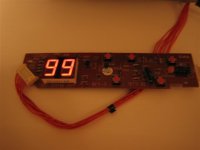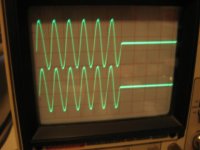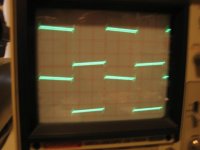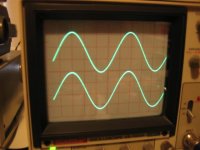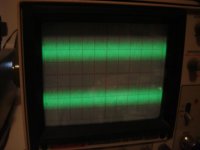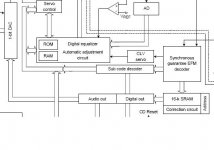which boombox?
I have to admit to being intimidated by reading hundreds of pages...
Is there a list somewhere of what are suitable boomboxes or other which have the right innards? I saw the first post making reference to JVC RC-EZ31. I have seen reference to JVC RC-EZ51. Are there others?
Peter
I have to admit to being intimidated by reading hundreds of pages...
Is there a list somewhere of what are suitable boomboxes or other which have the right innards? I saw the first post making reference to JVC RC-EZ31. I have seen reference to JVC RC-EZ51. Are there others?
Peter
I tried finding a service manual, but to no avail.I think the only way to see if this would be suitable or not is to try and get hold of a service manual online from somewhere, then see if it contains the same boards as the other two.
Failing that the only way is to buy one and take a chance I think.
It's cheap enough that I would be willing to just pick one up and tear it apart. It'll be fun and educational no matter what I find!
I am going to give this a few days to see whether someone has already bothered to do this. But suppose I go ahead, is there some place that lists what I would hope to be finding?
Peter
...is there some place that lists what I would hope to be finding?
Peter
You want Sanyo laser and these or similar chips on board:
LA9242
LC78601
LA6541
I will report back what's inside once I get it.
peter
Hi Peter,
This one seems promising, apparently it doesn't support MP3 playback so it might in fact have the right chipset for the Shigaclone. Guess we will have to wait and see.
The mad doctor at work!
Yep. Got the box today. Took it apart already. Photos tomorrow. But... I can say already that the main chip is a Toshiba: TC94A29FAG (http://www.datasheetcatalog.org/datasheet/toshiba/4225.pdf). I can't identify the other two major chips. On one I get hits: SA9258PH, but can't find any documentation. The other one is something like TA926A1, but the markings are badly smudged (removed?), so I am not sure. Don't get a hit on that one at all.
More tomorrow.
peter
Yep. Got the box today. Took it apart already. Photos tomorrow. But... I can say already that the main chip is a Toshiba: TC94A29FAG (http://www.datasheetcatalog.org/datasheet/toshiba/4225.pdf). I can't identify the other two major chips. On one I get hits: SA9258PH, but can't find any documentation. The other one is something like TA926A1, but the markings are badly smudged (removed?), so I am not sure. Don't get a hit on that one at all.
More tomorrow.
peter
fun while it lasted...
Well, I guess it's about time to chip in... (pun intended).
I’ve been running some basic tests on two Sanyo SF-P101N based units today and they are not as bad as I thought they’d be, even through the built in DAC.
Testing the entire unit loaded with 10k at the output results in a 560mV RMS swing- nice enough to drive a power amp.
The internal DAC is essentially ruler flat until from 20Hz to about 18 kHz and then it rolls off, unable to produce a clean 20 kHz sine wave. 0db,-20db and -40db are quite clean, but get to -60dB and the cheap DAC shows up a fair bit of noise and far more than even a cheap discrete CD player.
Current consumption at 8 volts regulated is up to 530mA at full sled swing to stop, 200mA when running and about 470mA when swinging through a disc searching.
100Hz square waves have some tilt (not much), leading edge lag and digital filter ringing, but no worse than a 1st or 2rd generation CD player.
Standard EIA tone bursts were essentially perfect, but they should be, even a first generation CD player could make textbook oscilloscope patterns.
A 15,999 kHz sine wave was reproduced as exactly 15,999 kHz so the cheap resonator is good enough- no expensive crystal needed there.
Inter-channel phase differences are non-existent even up to 20 kHz producing a perfect line when XY-ing Lissajous patterns. So, two DACs inside and they work quite nicely.
The problem occurs when you try to reproduce single impulses to test for polarity. They disappear! In fact ALL really short impulse tests disappear! I don’t know if it’s a DSP mathematical function or the DAC, I will investigate this further when I analyse the internal DAC’s output and compare it to my external DAC.
Another serious problem for any transport is the incredibly poor error correction- it cannot correct even small errors. Neither transport (I tested 2) was better than the other- they were both poor. So, the quality of the stream to your DAC is now totally suspicious as far as I am concerned. A transport cannot be regarded good if it cannot correct basic errors.
My old demo disc from the days when CD was first introduced got thrown around the shop and we used it until nothing would play it. The only machines that will track it are Sony X7/77esd or 338/707esd and one out of three CDM1 based CD84 Philips I have used. Everything else will have a go and play tracks 3,4,5 skip, jump etc. Anyway, the cheap Sanyo mechanisms will not do much except skip around and make interpolation noises. So, their tracking is utter crap too. Seriously, what do you expect from Mabuchi spindle motors driven by a single chip servo solution all run from one (1) 7808 regulator. I mean, a serious spindle motor is not a brushed motor, it is a slotless coreless hall motor and a tracking motor is a linear not another cheap brush motor on a plastic bearing reduction set rack.
I had to try it out, and it was fun ripping apart a few ghetto blasters and hotwiring them on the test bench. But let me assure you, they are not true hifi, and they never will be.
Bolting them into magnificently designed block of milled metal is no doubt enjoyable but you cannot make a silk purse from a sow’s ear.
I will upload shots of the testing if anyone is interested.
Well, I guess it's about time to chip in... (pun intended).
I’ve been running some basic tests on two Sanyo SF-P101N based units today and they are not as bad as I thought they’d be, even through the built in DAC.
Testing the entire unit loaded with 10k at the output results in a 560mV RMS swing- nice enough to drive a power amp.
The internal DAC is essentially ruler flat until from 20Hz to about 18 kHz and then it rolls off, unable to produce a clean 20 kHz sine wave. 0db,-20db and -40db are quite clean, but get to -60dB and the cheap DAC shows up a fair bit of noise and far more than even a cheap discrete CD player.
Current consumption at 8 volts regulated is up to 530mA at full sled swing to stop, 200mA when running and about 470mA when swinging through a disc searching.
100Hz square waves have some tilt (not much), leading edge lag and digital filter ringing, but no worse than a 1st or 2rd generation CD player.
Standard EIA tone bursts were essentially perfect, but they should be, even a first generation CD player could make textbook oscilloscope patterns.
A 15,999 kHz sine wave was reproduced as exactly 15,999 kHz so the cheap resonator is good enough- no expensive crystal needed there.
Inter-channel phase differences are non-existent even up to 20 kHz producing a perfect line when XY-ing Lissajous patterns. So, two DACs inside and they work quite nicely.
The problem occurs when you try to reproduce single impulses to test for polarity. They disappear! In fact ALL really short impulse tests disappear! I don’t know if it’s a DSP mathematical function or the DAC, I will investigate this further when I analyse the internal DAC’s output and compare it to my external DAC.
Another serious problem for any transport is the incredibly poor error correction- it cannot correct even small errors. Neither transport (I tested 2) was better than the other- they were both poor. So, the quality of the stream to your DAC is now totally suspicious as far as I am concerned. A transport cannot be regarded good if it cannot correct basic errors.
My old demo disc from the days when CD was first introduced got thrown around the shop and we used it until nothing would play it. The only machines that will track it are Sony X7/77esd or 338/707esd and one out of three CDM1 based CD84 Philips I have used. Everything else will have a go and play tracks 3,4,5 skip, jump etc. Anyway, the cheap Sanyo mechanisms will not do much except skip around and make interpolation noises. So, their tracking is utter crap too. Seriously, what do you expect from Mabuchi spindle motors driven by a single chip servo solution all run from one (1) 7808 regulator. I mean, a serious spindle motor is not a brushed motor, it is a slotless coreless hall motor and a tracking motor is a linear not another cheap brush motor on a plastic bearing reduction set rack.
I had to try it out, and it was fun ripping apart a few ghetto blasters and hotwiring them on the test bench. But let me assure you, they are not true hifi, and they never will be.
Bolting them into magnificently designed block of milled metal is no doubt enjoyable but you cannot make a silk purse from a sow’s ear.
I will upload shots of the testing if anyone is interested.
those chips in there... (pointer to pictures included)
John: I would be interested in seeing some of those measurements and also the methodology with which they were taken. I might attempt some myself just for the fun of it.
What you mention about the quality of the DAC... I was wondering about that. I looked at the data sheet for the LC78601 and am not too impressed with what the DA section claims (and your measurements seem to indicate that those numbers are very optimistic). The numbers on the TC94A29FAG are similarly mediocre. I can't quite figure out from the data sheet whether it's feasible to get something like an s/pdif style output. It certainly looks like it will take programming of the u-controller...
For the voyeurs out there you can see pictures of my surgery from last night at http://picasaweb.google.com/schro20/RDEZ11
out there you can see pictures of my surgery from last night at http://picasaweb.google.com/schro20/RDEZ11
Peter
John: I would be interested in seeing some of those measurements and also the methodology with which they were taken. I might attempt some myself just for the fun of it.
What you mention about the quality of the DAC... I was wondering about that. I looked at the data sheet for the LC78601 and am not too impressed with what the DA section claims (and your measurements seem to indicate that those numbers are very optimistic). The numbers on the TC94A29FAG are similarly mediocre. I can't quite figure out from the data sheet whether it's feasible to get something like an s/pdif style output. It certainly looks like it will take programming of the u-controller...
For the voyeurs
Peter
here are a few of the scope shots:
tno_99 displaying the maximum number of tracks on my test disc
toneburst showing a 1001Hz EIA toneburst
square 100Hz Square wave
18kHz sine
-60dB 1kHz -60dB note there is essentially very little except noise
All other tests used the DENON 1984 original pressing 99 track digitally derived digital audio test disc.
I will be looking at the EIAJ data stream today if I get a chance.
tno_99 displaying the maximum number of tracks on my test disc
toneburst showing a 1001Hz EIA toneburst
square 100Hz Square wave
18kHz sine
-60dB 1kHz -60dB note there is essentially very little except noise
All other tests used the DENON 1984 original pressing 99 track digitally derived digital audio test disc.
I will be looking at the EIAJ data stream today if I get a chance.
Attachments
Peter, the 94A29FAG (great suffix huh) is no good to you. An amazing chip but no digital out. That being said if you can hack out the cd part you can at least build a banger that won't sound too bad.
I have attached the part from the datasheet and you can see the digital goes straight to the 1 bit DAC.
I have attached the part from the datasheet and you can see the digital goes straight to the 1 bit DAC.
Attachments
Hallo Shigaclone owners and people are building one,
Here can you find some pictures from my Shigaclone, sorry it is Dutch but the pictures tells a lot how it is build.
http://www.htforum.nl/yabbse/index.php?topic=86768.0
Greetings,
Rudy
Here can you find some pictures from my Shigaclone, sorry it is Dutch but the pictures tells a lot how it is build.
http://www.htforum.nl/yabbse/index.php?topic=86768.0
Greetings,
Rudy
Hi guys, I can't imagine this topic went to this point. Last time I was here at around page 120something , guess.
Wonder what you did in the mean time. Afraid you might teach shigaclone to pick up CDs from shelf and store them back
EDIT:
Must be new repagination model by diyaudio forum. Ahh My mistake, Sorry. Keep on good work guys.
Wonder what you did in the mean time. Afraid you might teach shigaclone to pick up CDs from shelf and store them back
EDIT:
Must be new repagination model by diyaudio forum. Ahh My mistake, Sorry. Keep on good work guys.
Last edited:
Well, I guess it's about time to chip in... (pun intended).
<snip>
I had to try it out, and it was fun ripping apart a few ghetto blasters and hotwiring them on the test bench. But let me assure you, they are not true hifi, and they never will be.
Bolting them into magnificently designed block of milled metal is no doubt enjoyable but you cannot make a silk purse from a sow’s ear.
I will upload shots of the testing if anyone is interested.
Assuming you are talking about the mechanism and chip set found in the RCEZ31/32 and repurposed for use in the Shigaclone I've observed many of the shortcomings you have noted, but through my outboard dac it manages to sound quite a bit better than you might expect. The fact that it has lousy error correction and pretty mediocre specs belies the point that it does produce a pretty good quality spdif signal when everything is working ok. No one recommended that the internal dacs be considered for serious use - they clearly aren't up to snuff. I take pretty good care of my CDs and I haven't had any of the hundreds I own not play properly in the Shigaclone - including ones that will not play at all in any computer drive I own. (Too many errors)
Many relatively inexpensive cd players use mabuchi dc motors and achieve decent results. The only machine I have ever owned that did not was a PS Audio Lambda Drive and it had its own set of problems and did not seem to do a particularly better job as a transport sonically speaking. (This machine used the vaunted Philips CDM-9 Pro mechanism, [hall effect motor, voice coil actuator for tracking] which IMO regardless of its wonderful specifications is the biggest piece of cr*p I have ever had the misery of dealing with. It died very young.) In the end regardless of performance potential I was quite disappointed with the PSA Lambda Drive and am a lot happier with my realization of the Shigaclone.
Before you dismiss it entirely you might just want to try it. You might be as surprised as I was. I was just looking for something fun to play with and had no expectation that it would be a giant killer (Which from your viewpoint it may not be.) or even decent. BUT IMO I think Peter was right, and I have heard some of the 47 labs gear including the Shigaraki which made waves here when introduced. (The Shigaraki uses this motor, laser assembly and chip set..)
Not to put too fine a point on it, but none of your comments are going to detract in any way from my enjoyment of the Shigaclone and I suspect that most people who have built one based on Peter's ideas will feel the same way.
Last edited:
- Home
- Source & Line
- Digital Source
- Finally, an affordable CD Transport: the Shigaclone story
